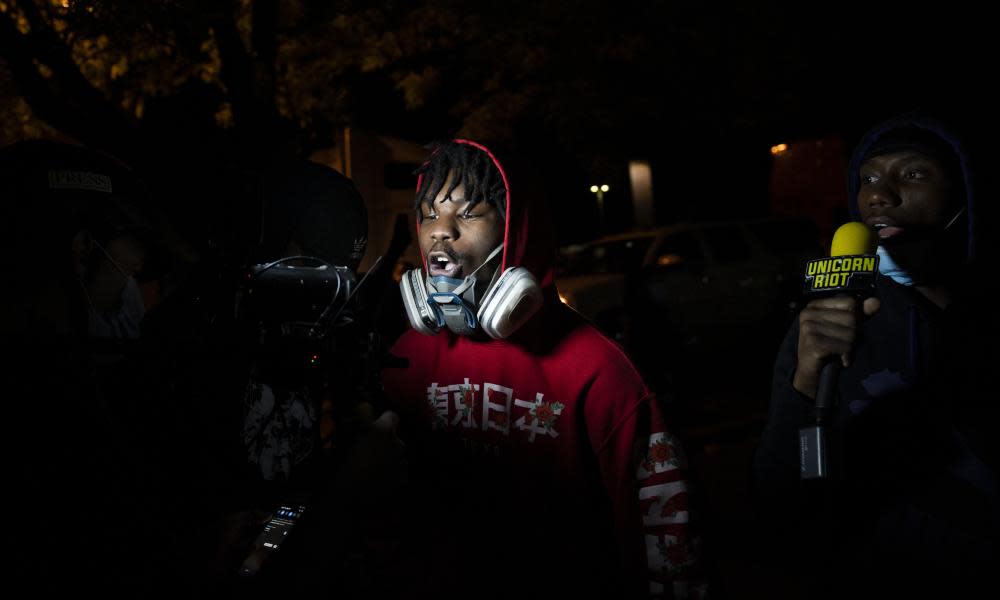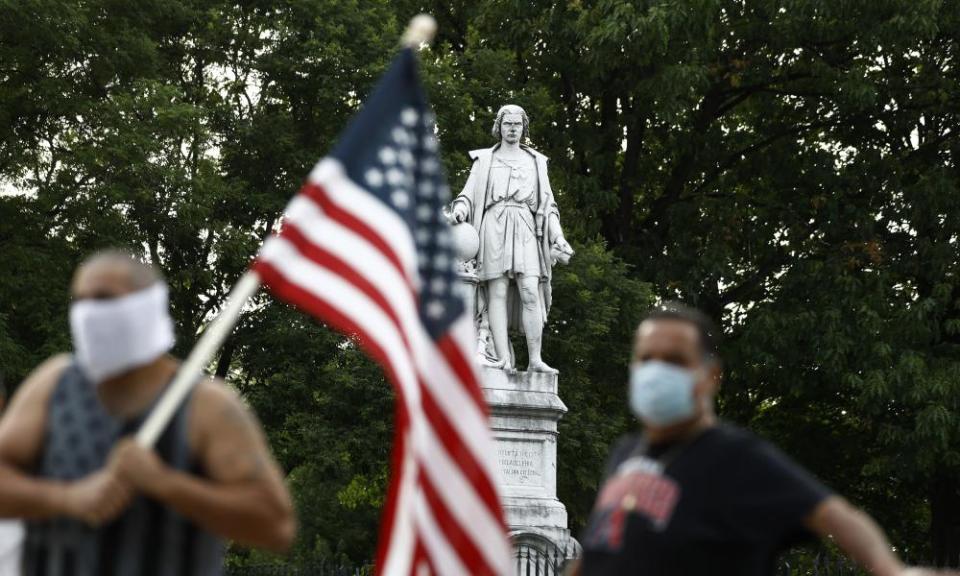Unicorn Riot: the tiny media outlet on the frontlines of US protests

As protests over the killing of George Floyd by a white police officer have gripped Minneapolis and many other major US cities over recent weeks one previously unknown news organization has sprung to the fore.
Unicorn Riot, a small non-profit with just eight correspondents, has reported, often via live stream, some of the most engrossing, and frequently shocking, footage of the protests that have spread across the US.
In some cases Unicorn Riot reporters have become targets for violence themselves, as they have documented the heavy-handed policing and pugnacious rightwing counter-demonstrations that have accompanied the George Floyd protests.
Related: 'Denigrated and discredited': how American journalists became targets during protests
“We’ve been covering police killings a ton in this area for the last five years,” said Niko Georgiades, one of the founders of Unicorn Riot. At the time of Floyd’s death Unicorn Riot was working on a documentary called The Mothers based on interviews with women whose children had died at the hands of police.
“So it’s definitely not something new to us, this whole topic,” Georgiades said.
When they cover protests Unicorn Riot – the name was drawn from a pot of founders’ suggestions, and has “provided a huge conversation starter”, Georgiades said – puts out live stream coverage and then cuts digestible videos and publishes written articles.
“It’s long days, but I’m pretty dedicated. For me personally, I’m dedicated because I feel it’s really needed right now,” Georgiades said. “I’ve been doing probably 15 hours a days. Some days it’ll be like 18.”
The frontline work is not without dangers.
In mid-June a Unicorn Riot journalist filmed as a group of people – mostly male, mostly white – gathered around a statue of Christopher Columbus. Across the country a number of problematic monuments and statues have been torn down by protesters in recent weeks.

As reporter Chris Schiano filmed, he was confronted by a group of men, some carrying baseball bats. His video, which tens of thousands of people liked and retweeted on Twitter, showed more than one man attempting to grab Schiano’s camera, and another attempting to drag off his bicycle. Another member of the crowd then emerged and slashed the tires of the bike.
The reporter was assaulted “multiple times” over the course of the protest, Unicorn Riot said.
Racist vigilantes gathering with bats and guns at the statue of Christopher Columbus at Columbus Square in South Philadelphia, some of them just assaulted our reporter pic.twitter.com/kvUn9dLTaV
— Unicorn Riot (@UR_Ninja) June 14, 2020
It is those raw moments, frequently shared on Twitter and beyond, which have brought newfound attention to Unicorn Riot. The rapid rise has seen the organization, a non-profit which in early May was struggling to raise $5,000 to pay for equipment and staff wages, receive $1m in donations in roughly four weeks.
Its founders say the money will secure Unicorn Riot’s future, and some will be spent on working with young people of color, encouraging the “next generation” of journalists.
“It’s been super humbling, and it’s been super amazing and incredible, and it shows our five years hasn’t been in vain,” Georgiades said. “But this new found interest in us, this new found love for our work, unfortunately came off of a black death. That’s something we really need to be cognizant of, I don’t take that lightly.”
This new found interest in us, this new found love for our work, unfortunately came off of a black death. I don’t take that lightly
Niko Georgiades
The money will be used, in part, to pay contributors – specifically people who are not “white, mainstream contributors”, and teaching young people in journalism.
It’s been a slow burn for Unicorn Riot, which is frequently categorized as left-wing. It was formally founded in 2015 by a group of journalists, some of whom had cut their teeth covering Occupy Wall Street protests, others who had reported from Ferguson, where protests broke out over the police shooting of Michael Brown in 2014.
“We knew the media was having difficulty with the narrative,” Georgiades said. “There were a lot of movements – the tar sands movement, the Occupy movement, just people fighting for change in multiple arenas – who were not getting their voices heard.”
Georgiades said: “We knew that we could try to be a shield for community to not have the corporate news come and sort of distort their story. We could be the microphone for the community and let the community speak.”
While Unicorn Riot sprung to the fore as an outlet that covers protests and demonstrations – in May 2017 it covered a planned neo-Nazi protest at the Minnesota capitol building, before that its journalists reported on the Standing Rock protests against the Dakota Access pipeline in North Dakota – its work goes beyond civil unrest.
In Denver, Unicorn Riot has covered the city’s housing crisis since 2015. A recent Icebreaker series was based on homeland security manuals that were leaked to Unicorn Riot, enabling it to report on how police “were constantly using Facebook surveillance of protesters and interagency cooperation to target specific protest organizers” who were demonstrating against the police shooting of Philando Castile in Minnesota.
Unicorn Riot believes the surge in donations should now ensure its future for years to come.
“All of our members are super dedicated. None of us do it for the money. We do it for the stories, and the ability to have this platform for the community,” Georgiades said.

